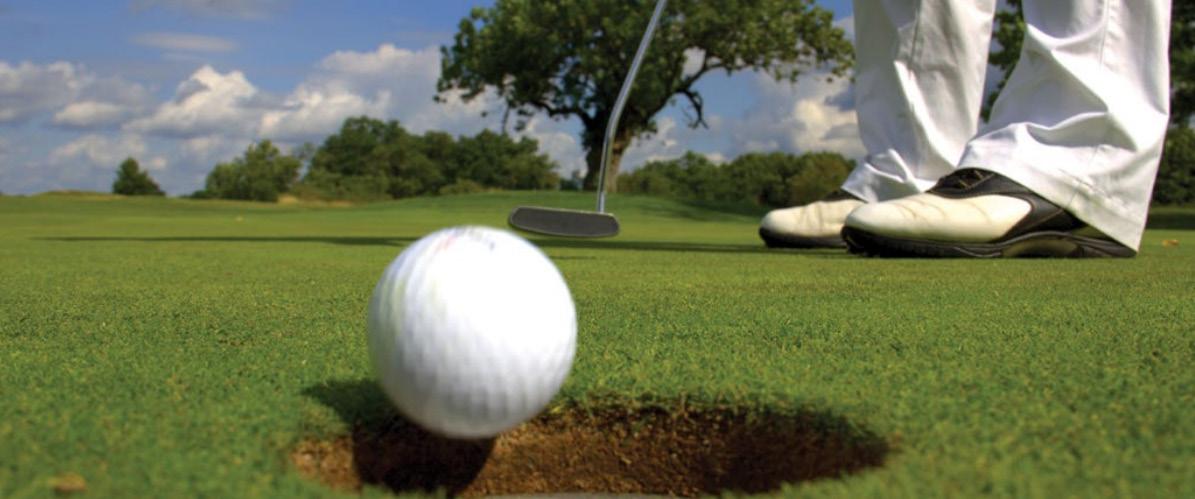
4 minute read
HOW TO PLAY A LINKS COURSE
Links golf courses lie on often remote stretches of land close to the sea. Playing a links is an exhilarating but demanding experience. You’re exposed to extreme weather conditions and usually play in winds far stronger than you ever experience inland.
From a distance such a course looks flat and quite featureless. But once you set foot on a links you discover that the ground is a mass of humps and hollows - many of the tee shots you face are semi-blind.
Advertisement
Hard, fast running fairways can cause the occasional unpredictable bounce. Your ball may shoot forward on the first bounde, while the same shot pitching into a hump stops quickly. If you’re very unfortunate a ball flying straight down the middle of the fairway kicks into the rough.
The short grass and closely mown fairways on a links course can remove some of the fear from your mid-range approach shots to the green. A crisply struck iron shot generates a great deal of backspin because very little grass comes between the clubface and the ball at impact.
WATCH THE WIND
Strong wind is an important feature of links golf, so make sure you use it to your advantage whenever possible. Try to forget the distance you usually hit the ball - wind drastically alters your nomal club selection.
Into the wind demands a precise strike. Always take plenty of club and swinger shorter than normal. A three-quarter shot helps you hit the ball lower to give you more control in the wind.
Remember that playing into the wind exaggerates the spin off links turf and you can stop the ball even on firm greens.
Wind behind should encourage you to hit the ball higher to gain maximum distance on the shot. With luck you can reduce long par 5s to a comfortable 4 strokes and look for birdies on par 4s.
Downwind it’s difficult to put enough backspin on the ball to pitch and stop it neatly on the green. Take less club, swing smoothly and let the wind carry the ball towards the target. Aim to pitch the ball well short of the green and expect plenty of run on the shot.
Cross winds force you to aim way off line and allow the ball to be blown back on target. Depending on the strength and direction of the wind, select a spot to one side and set up to hit the ball straight at it. Swing normally and let the wind do the rest.
SHORT GAME STRATEGY
Many golfers forget that wind affects the short game as well as the longer shots. This is especially true on a links course. When you chip from close to the green your main thought must be to keep the ball near the ground. A low pitch and run is always a safer shot in wind than a high lob.
A 7 iron is the ideal club for the shot. The ball runs twice the distance it travels in the air, so select an area to pitch the ball on and visualize it running towards the hole.
Grip down the club and position the ball towards the center of your stance. Swing the club as you do witha long putt - the arms moving back and through togther with very little wrist break. Make sure you keep your hands ahead of the ball throughout to promote a crisp strike.
Bear in mind that a long putt on a large sloping links green can often take two or three different breaks. It;s important to study the slope of the green carefully. Look at a putt along the ball-to-target link and then from the side on to give you a better perspective. Wind also affects the roll of the ball.
Set yourself realistic goals - occasionally a long putt drops but you should never be disappointed to get down in 2 strokes.
DEEP TROUBLE
Bunkers are hard to spot in the humps and hollows of a links course and devillishly difficult to escape from. A yardage chart comes in useful if you’re not familiar with the course - it can perform the role of an experienced caddie.
Study the chart and lay up short of bunkers if necessary. Don’t take risks - it’s fine to sacrifice distance, particularly if it keeps you on the fairway.
When you land in a fairway pot bunker it’s unlikely you have a direct route to the green - concentrate on making sure you next shot isn’t from the same spot. The powdery fine sand is perfect for the high splash shot. Open your stance and keep the clubface open. Swing long and smooth on an out-to-in path.
Huge sandy dunes are punishing hazards that surround many fairways and greens. You’re bound to be faced with an awkward stance and the thick, wiry grass doesn’t let go of your ball easily.
Play your recovery with a sand wedge and grip the club tight. It’s difficult to achieve any distance, so don’t be too ambitious with your escape.










